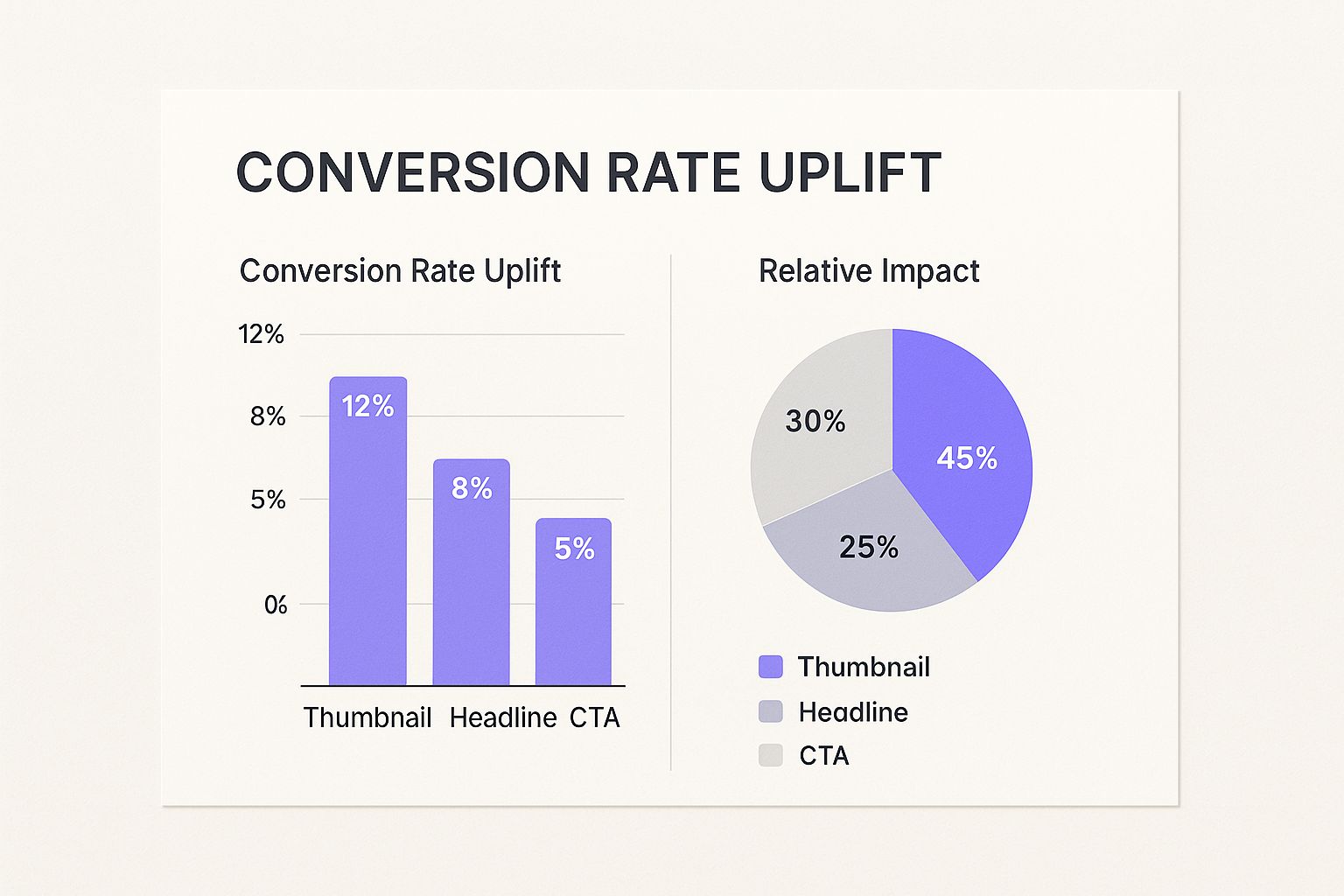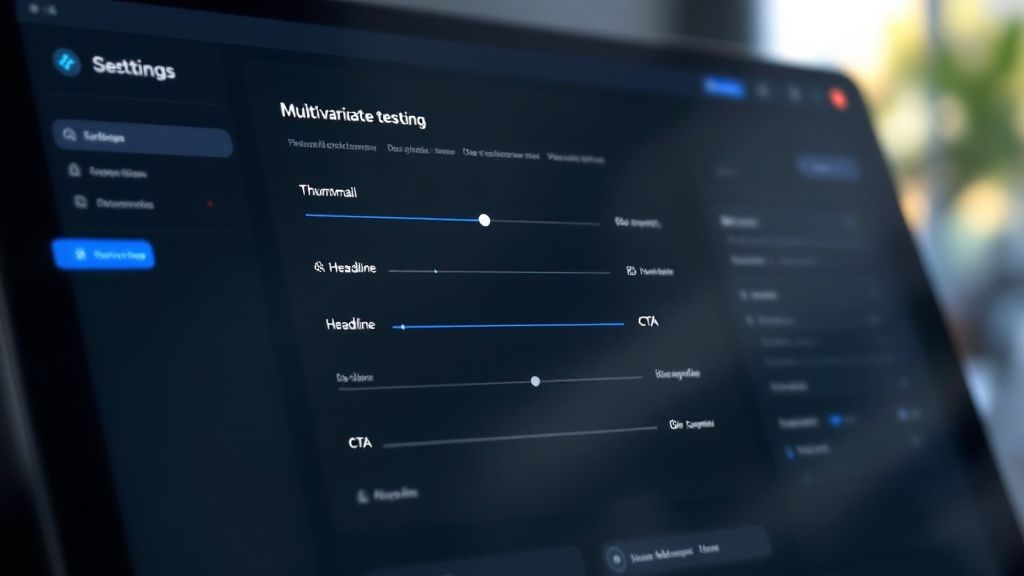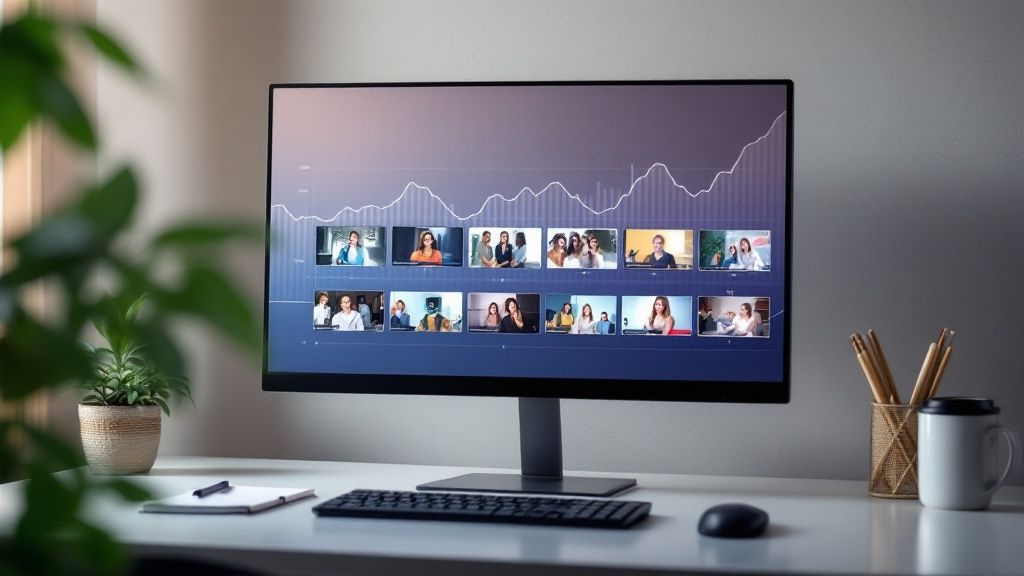Understanding Multivariate Testing In Video Marketing

Multivariate testing for video creatives is a powerful technique. It allows marketers to analyze multiple video elements at the same time. This differs from traditional A/B testing, which only compares two versions. Multivariate testing provides a more detailed understanding of how different components work together. It also shows how these components contribute to overall video performance. You can test different combinations of thumbnails, headlines, calls-to-action, and video lengths. This helps you find the perfect formula for success.
Why Multivariate Testing Matters
Imagine promoting a new product with a video ad. Instead of testing just two thumbnails, multivariate testing lets you test several thumbnails, headlines, and calls to action all at once. This approach reveals winning combinations that simple A/B testing might miss. It also provides deeper insights into which element most strongly influences viewer behavior. You might be interested in this article: How to master multivariate video ads.
Multivariate testing has become more important because it can improve ad performance. It analyzes multiple variables simultaneously to pinpoint which elements contribute the most to success. This could include headlines, images, or calls-to-action. As a result, marketers can optimize their campaigns more effectively. Learn more about how AI influences multivariate testing.
Statistical Foundations and Sample Size
The power of multivariate testing comes from its statistical basis. However, you don’t need advanced statistical knowledge to use it well. The key is understanding the connection between sample size and statistical significance. A larger sample size increases your confidence that the results are accurate and not random. This is important for practical sample size determination in real campaigns.
There’s no single answer for the perfect sample size. A good rule of thumb is to aim for enough views for each variation. This is so you can reach statistical significance. This often requires careful planning and budgeting, especially when testing multiple elements at the same time. For example, testing four thumbnails, three headlines, and two calls to action results in 24 (4x3x2) variations total. This highlights the importance of planning and resource allocation.
Structuring Effective Tests
How you structure your multivariate test is critical for getting usable insights. The first step is clearly defining your goals. What are you trying to achieve? Are you looking for higher click-through rates, more engagement, or increased conversions? Knowing this will help you select the right variables and metrics.
Next, create distinct variations. These differences should be large enough to create measurable results. Testing small changes might not produce noticeable differences. Testing too many variables at once can dilute your data. This can make it difficult to identify the winning combination. Carefully consider how your variations interact and focus on testable hypotheses.
Finally, set a clear timeframe for your test. How long will it run? This depends on several things. Your budget, target audience size, and the platform you're using are all factors. A clear timeframe ensures you collect enough data to reach meaningful conclusions. This structured approach helps marketers get valuable insights. They can then use these insights to improve their video campaigns.
Identifying High-Impact Video Elements To Test
Not all parts of a video contribute equally to its success. Some have a much bigger impact on important metrics like click-through rates, engagement, and conversions. By looking at successful video marketing campaigns, we can figure out which elements really make a difference and focus on those in our testing strategy.
The Power of the Thumbnail
It might surprise you, but the thumbnail image often matters more than the video itself. This is because the thumbnail is the first thing a viewer sees, and sometimes the only thing. It decides whether someone clicks to watch. A good thumbnail grabs attention and makes people want to learn more, especially in busy feeds. This means optimizing your thumbnail is crucial for video success.
Opening Hooks and Captivating Attention
Once a viewer clicks, the first few seconds are key. The opening hook needs to be strong enough to keep them watching. Different hooks work for different audiences and content, but some good ones include asking a question, sharing a surprising statistic, or showing something visually amazing. The goal is to instantly grab the viewer and make them curious about what's next.
Subtle Changes, Big Impact
Even small things like color schemes and text overlays can change how viewers react. For example, contrasting colors can make your call-to-action stand out, and well-placed text can emphasize important messages or highlight special offers. Testing lets you try these small changes and see which ones work best for your audience. These insights can really improve engagement and conversion rates.
The infographic below shows how different video elements affect conversion rates. It compares the improvements from optimizing thumbnails, headlines, and calls-to-action.

As you can see, thumbnail optimization gives the biggest conversion boost at 12%, then headlines at 8%, and calls-to-action at 5%. The pie chart shows thumbnails make up 45% of the total impact, headlines 30%, and calls-to-action 25%. This really highlights how important thumbnail testing is.
Prioritizing Your Testing Efforts
It's tempting to test everything at once, but it's smarter to prioritize based on potential impact and how hard the test is to set up. Focus on elements that are likely to have big results, like thumbnails and opening hooks. As you have more resources, you can test other things like color schemes, text overlays, and calls-to-action.
To help prioritize, let's look at a helpful table:
To help prioritize testing efforts, consider the following matrix which ranks video elements based on their potential impact and the complexity of testing them:
Video Creative Elements Testing Priority Matrix: Priority ranking of video elements to test based on impact potential and implementation complexity
| Element | Impact Level | Testing Difficulty | Recommended Priority |
|---|---|---|---|
| Thumbnail | High | Low | High |
| Opening Hook | High | Medium | High |
| Call to Action | Medium | Low | Medium |
| Color Scheme | Low | Medium | Low |
| Text Overlay | Low | Medium | Low |
This table clearly illustrates that focusing on Thumbnails and Opening Hooks offers the greatest potential return on investment for your testing efforts due to their high impact and relatively low to medium testing difficulty.
Practical Frameworks for Success
By using this data, you can make effective videos that grab attention, get people involved, and help you reach your marketing goals. Platforms like Trello can help organize this process. Trello lets you create and test many variations efficiently, which improves your testing strategy. Successful video marketing isn't about guessing—it’s about figuring out and improving the things that really matter. This helps you get the best results and return on investment.
Building Testing Frameworks That Actually Work

Successful multivariate testing for video creatives isn't about making random changes and hoping for a miracle. It's about having a structured, systematic approach. This gives you reliable, actionable results. In other words, it's about building a testing framework that actually works. This framework guides your experiments. It makes sure you're not just collecting data, but getting real insights.
Defining Testable Hypotheses
A good test starts with a strong hypothesis. Don't just test different versions at random. Instead, ask a specific question.
For example, ask, "Will using brighter colors in the thumbnail increase click-through rates?" This focused approach helps you design variations that answer your question directly. It also makes it easier to understand the results. This helps you reach useful conclusions.
Determining Sample Size
The right sample size is crucial. A sample that's too small might mislead you. A sample that's too large can be expensive and time-consuming.
Find a balance. Aim for a sample size that gives you statistically significant results. But, it should also be manageable within your budget. This requires balancing your resources and your predicted outcomes. You might find this helpful: How to reduce CPA with video variants.
Establishing Success Metrics
Before starting your test, define clear success metrics. What are you trying to achieve? More views? Higher engagement? Increased conversions?
Clear goals keep you focused. They help you measure your test's impact. For example, if you want better conversions, track how each variation drives sales or sign-ups.
Structuring Test Variations
Don't test too many things at once. This can create confusing results. It's better to create different variations. Each variation should test a few elements at the same time. This helps you isolate the impact of each change. It also makes it easier to find the best combination of elements.
Consider the role of AI in video marketing. AI tools are increasingly common. 51% of video marketers use AI for creating or editing videos. However, this has decreased from previous years. This shows how video marketing is always changing. It highlights the ongoing development of multivariate testing and AI integration. See more detailed statistics here. A good testing framework helps you navigate these changes. It helps you optimize your videos for maximum impact.
Leveraging Technology For Scalable Video Testing
AI-powered platforms have greatly improved multivariate testing for video creatives. These platforms allow for the quick and efficient creation and analysis of many different versions. This section explores how marketers use artificial intelligence in their testing strategies and how this maintains brand consistency and creative quality.
Automating the Testing Workflow
Leading marketers are incorporating AI into their video testing workflows. AI automates tedious tasks, like generating variations of video elements. For example, AI can create multiple video thumbnails with different colors, fonts, and images. This allows marketers to focus on strategy and analysis. AI can also analyze large amounts of data, uncovering patterns and insights humans might overlook.
Finding the right balance between human creativity and machine efficiency is key. AI is a powerful tool, but it shouldn't completely replace human judgment. Marketers should use AI for automating repetitive tasks and identifying trends while maintaining control over the creative direction. Sprello helps with this, using AI-powered features to create multiple video variations within minutes. This lets you maintain control while benefiting from AI’s efficiency.
Evaluating AI Testing Platforms
Many automated testing tools are available, but their quality varies. Some over-promise and under-deliver. It’s crucial to discern real value from marketing hype. When evaluating AI testing platforms, look for these features:
- Robust data analysis capabilities: The platform should provide deep insights into each variation’s performance.
- Flexible testing options: You should be able to test multiple variables simultaneously and control individual elements.
- Seamless integration with existing workflows: The platform should integrate smoothly with current processes.
- Scalability: The platform needs to handle large amounts of data and variations as your needs change.
Real-World Capabilities and Limitations
Talking with performance teams using these technologies gives a realistic view of AI’s capabilities and limits. AI can significantly accelerate testing and identify winning variations. However, it's not a perfect solution. AI still requires human guidance and can struggle with subtle creative decisions involving subjective judgment.
The Future of Video Creative Optimization
Emerging trends are constantly shaping video testing's future. These include advancements in machine learning algorithms, improved data analysis techniques, and the increasing use of personalized video content. As AI evolves, it will likely play a larger role in video creative optimization. This allows marketers to build highly effective, targeted campaigns. Understanding this evolving landscape is crucial for competitive video marketing, helping marketers harness AI’s power for maximum impact.
Measuring What Matters In Video Performance

Looking past vanity metrics such as view counts is essential to truly grasp video performance. Understanding the important metrics differentiates successful marketing campaigns from budget drains. This means focusing on key performance indicators (KPIs) that align with your business objectives. These can include engagement patterns suggesting purchase intent, or conversion tracking that maps the customer journey.
From Views to Value: Connecting Video and Revenue
Building a solid analytics framework is the first step. This framework should link video views with revenue attribution. Demonstrating the actual business value of your videos is crucial. For example, you can monitor which videos drive traffic to your website, product pages, and finally, sales. Also, consider the impact of video on brand awareness and customer loyalty, even without direct sales. These factors contribute to a comprehensive view of video effectiveness.
Calculating True ROI from Testing
Multivariate testing for video creatives becomes especially insightful when you calculate the return on investment (ROI). Don't just track conversions; also incorporate the costs of creating and testing different versions. If a successful variation increases sales by 10% but costs 5% more to produce, your net ROI is 5%. This data-driven method helps you decide which video variations are worth expanding.
Presenting Compelling Results
Communicating results clearly to stakeholders is also important. Emphasize the bottom-line impact of your testing. Show how optimized videos contribute to increased revenue, higher conversion rates, or other goals. Present data clearly and concisely, highlighting the value generated. Clear communication fosters support for future testing.
Scaling Winning Variations and Maintaining Performance
Understanding when to scale winning variations is essential. Scaling too early may lead to diminishing returns, while waiting too long means missed opportunities. Aim for consistent results across audiences and platforms. This suggests the variation has broad appeal and is likely to scale well. Continuously monitor performance as you increase spending to maintain strong results, adjusting your strategy as needed.
To give you a better understanding of industry standards for video testing, let's look at some benchmark data.
Video Testing KPI Performance Benchmarks
| Metric | Good Performance | Excellent Performance | Testing Impact |
|---|---|---|---|
| View-Through Rate (VTR) | 25% | 40% | Measures audience engagement and video completion |
| Click-Through Rate (CTR) | 1% | 2% | Gauges the effectiveness of calls to action |
| Conversion Rate | 2% | 4% | Tracks how well videos drive desired actions |
| Cost Per Acquisition (CPA) | $50 | $25 | Measures the cost-effectiveness of conversions |
| Engagement Rate | 5% | 10% | Reflects audience interaction with the video |
This table presents general benchmarks. Actual performance may vary depending on industry, target audience, and other factors. Use this as a starting point for setting your own performance goals and measuring the success of your video testing efforts.
93% of marketers report a positive ROI from video marketing. This highlights video's importance in modern marketing. Shoppable videos, optimized through multivariate testing, can boost sales by 3.4 times. This underscores the potential of video creatives to drive conversions. For more statistics, see this blog post. Focusing on these crucial metrics enables data-driven decisions and maximizes your video marketing impact.
Key Takeaways For Video Testing Success
Building on the strategies already discussed, let's break down the core principles for successful multivariate testing for video creatives. This practical roadmap provides actionable steps, realistic timelines, and measurable benchmarks to guide your testing process.
Building Internal Capabilities for Ongoing Optimization
Developing internal expertise is key for long-term success. Start by fostering a culture of experimentation within your team. Encourage curiosity, hypothesis-driven testing, and data-driven decision-making.
Invest in training and resources to empower your team with the skills and knowledge they need for effective multivariate testing. This might include workshops on testing methodologies, analytics platforms, or tools that utilize AI.
By building these internal capabilities, you create a sustainable system for continuous improvement and stay ahead of the curve.
Avoiding Common Pitfalls
Many marketers fall into common traps that hinder testing effectiveness. One frequent mistake is testing too many variables at once. This can dilute the data and produce inconclusive results, making it difficult to pinpoint which elements are driving performance.
Another pitfall is neglecting statistical significance. Ensure your sample size is large enough to provide reliable results, avoiding misleading conclusions based on insufficient data.
Finally, failing to define clear success metrics before starting a test can lead to wasted budget and effort. By avoiding these common errors, you can maximize the impact of your testing.
Establishing Processes for Testing Integration
Integrating testing into your overall video marketing strategy is essential. Establish clear workflows and responsibilities for every stage of the testing process, from developing a hypothesis to analyzing results.
Document your testing procedures. This includes the metrics used, the variations tested, and the results obtained. This creates a valuable knowledge base for future campaigns and ensures consistent application of best practices.
Regularly review and refine your testing processes to adapt to evolving platform algorithms and audience behaviors.
Actionable Steps and Clear Indicators
Start small: Begin by testing one or two key elements, like thumbnails and headlines. As you gain experience, gradually expand the scope of your tests.
Set realistic timelines: Testing takes time. Allow sufficient time for data collection and analysis, and avoid premature conclusions based on limited data. A typical test might run for a week or two, depending on your campaign goals and audience size.
Track your progress: Monitor key metrics throughout the testing period, looking for trends and patterns. Use dashboards and reporting tools to visualize your results and communicate them effectively to stakeholders.
Benchmarks for Measuring Progress
The table below provides industry benchmarks for key video performance indicators:
| Metric | Good Performance | Excellent Performance |
|---|---|---|
| Click-Through Rate (CTR) | 1-2% | >2% |
| View-Through Rate (VTR) | 25-40% | >40% |
| Conversion Rate | 2-4% | >4% |
| Cost Per Acquisition (CPA) | Varies by industry | Lower is better |
These benchmarks serve as a general guideline. Your target performance levels may vary based on your specific industry, target audience, and campaign goals. Use these benchmarks as a starting point for setting realistic expectations and measuring your testing progress.
By implementing these key takeaways, you can establish a robust and effective testing framework. This framework will consistently deliver valuable insights and drive measurable results for your video marketing campaigns.
Ready to improve your video marketing results with AI-powered creative testing? Sprello is the solution. Create high-performing user-generated content (UGC) style ads in minutes, automatically generate diverse video variations, and optimize performance with data-driven insights. Start your free trial today and unlock the full potential of your video marketing strategy. Discover the power of Sprello.



